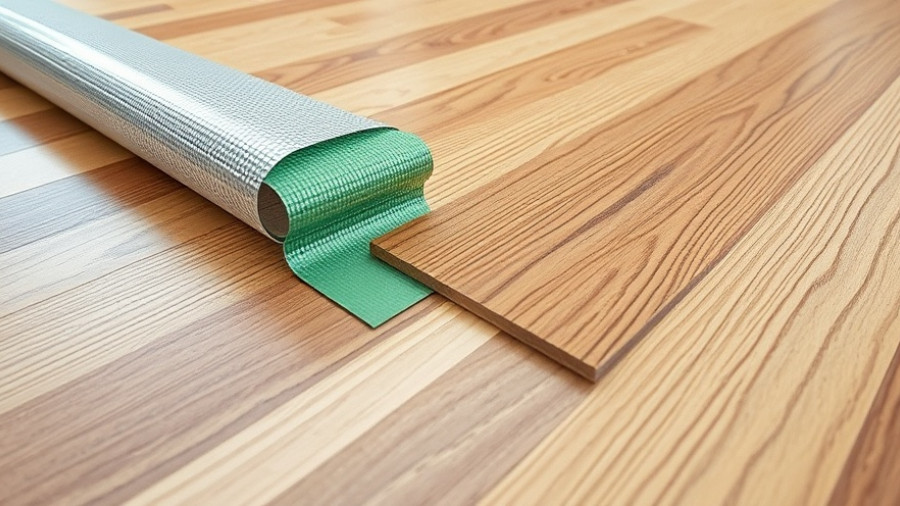
Transform Your Space: Creative Kitchen Tile to Wood Floor Transition Ideas
If you're a homeowner dabbling in DIY projects and home renovations, enhancing the aesthetics of your kitchen through carefully selected flooring transitions is an exciting endeavor. The fusion between tile and wood flooring can create visual interest and add refinement to your overall space. Understanding the best ways to transition between these two materials will not only elevate the look of your kitchen but also enhance its functionality.
Why Floor Transition Matters: Beyond Aesthetics
Floor transitions serve multiple roles in kitchen design—not just as a peculiarity of style but as essential elements that enhance safety, functionality, and flow. You may find yourself wondering, "How can I ensure my tiles and wood flooring meet seamlessly?" The answer lies in selecting the right transition style. A well-executed transition accounts for height differences, prevents tripping hazards, and invites a flowing harmony between spaces, ultimately contributing to a comfortable and stylish environment.
Metallic Transition Strips: Industrial Elegance
One of the most functional and stylish choices for a kitchen tile to wood floor transition is the use of metallic strips. These strips can create a striking contrast against warm wooden floors while also being incredibly durable. Imagine a stainless steel transition strip gracefully guiding the eye from the cool tiles of your kitchen to the cozy warmth of natural wood floors. This solution perfectly embodies modern design ideals while maintaining practical benefits.
The Art of Customized Geometric Transitions
Creating a customized geometric transition is a fantastic way to celebrate your creativity while blending tiles and hardwood floors fluidly. If your kitchen features tiles designed to mimic wood, consider employing intricate geometric patterns that subtly guide the eye across the junction. This attention to detail creates a sophisticated aesthetic and invites exploration through different textures and designs.
Eclectic Mix: Wood and Tile Boards
For those looking to make a bold stylistic statement, combining tiles with wooden boards of equal size can be a winning choice. This approach lets each flooring type shine on its own while also celebrating their unique aesthetics. The sleek lines of tiles contrasting with the organic textures of wood provide a stunning visual interplay—perfect for defining spaces in open-plan kitchens.
The Dramatic Impact of Tile Inlays
Imagine walking over a beautifully designed tile inlay that serves both as a transition and a decoration centerpiece in your kitchen. By embedding tiles with distinct designs into the hardwood flooring, you not only create a smooth transition but also an artistic point of interest. This method is especially impressive when hosting gatherings, showcasing your creativity with every step taken across the space.
Innovative Ideas for Unique Transitions
Explore these additional captivating transition ideas:
- Zigzag Patterns: Bold and energetic, zigzag patterns create an eye-catching dynamic as they flow seamlessly into wood flooring.
- Curved Transitions: For a more graceful and soft look, consider incorporating a curved transition that flows gently between materials.
- Mosaic Designs: Use small tiles to craft a mosaic transition that channels creativity and serves as a vibrant focal point.
- Barriers of Art: If you have artistic inclinations, why not let your personality shine through with unique pattern arrangements that merge tiled and wooden spaces?
Maintenance and Functionality: A Critical Consideration
When implementing any transition style, it’s imperative to consider the maintenance and durability aspects. Metal strips may require minimal upkeep, while wooden thresholds might require regular treatment to maintain their luster. The choice of materials should reflect not only design preferences but also the anticipated traffic in your kitchen to ensure they stand the test of time.
Stepping into Your Dream Kitchen
With these artistic and practical kitchen tile to wood floor transition ideas, transforming your kitchen into a designer space is within reach. Embrace the opportunity to explore your personal style, whether that leads you towards a more subdued aesthetic or a vibrant, bold display. Remember, every element in your kitchen can work together to create a cohesive and inviting atmosphere, highlighting your home’s unique charm.
Feeling inspired? Begin your journey today and start planning your kitchen upgrade with these insightful transition ideas!
 Add Row
Add Row  Add
Add 




Write A Comment